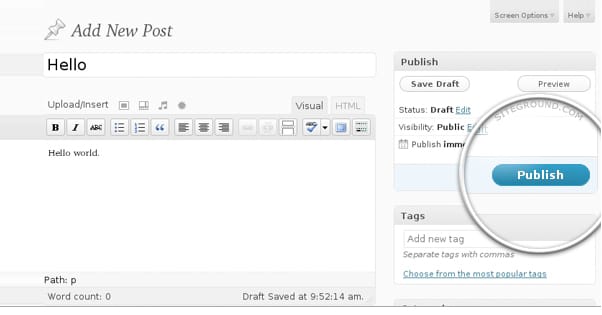6 Steps to Run a Content Marketing Campaign on a Budget
Published by James Parsons • Content Marketing • Posted July 14, 2015 ContentPowered.com
ContentPowered.com
Studies have shown that over 90% of all B2C marketers use content marketing these days. Those studies don’t say how expensive it is or how successful they are, but one thing’s for sure; it wouldn’t be that widely adopted if it didn’t work.
I know that small businesses, and sometimes even decently sized businesses, run on a very tight budget. It’s difficult, then, to invest in a marketing plan that calls for a constant web presence, full time workers producing content, and often expensive tools.
The good news is that you don’t have to dump a ton of money into content marketing. Part of the reason it has become such a prevalent marketing technique is because it’s entirely possible to do with one person, a bunch of time, and zero money.
Of course, that requires that you value your time fairly low. Time is valuable as a resource, just as money is. I’m going to give you ideas and methods for running content marketing using time but no money. Just bear in mind that every step of this process can be streamlined or sped up with money, to save you time. The balance is one you’ll have to strike for your own business.
1. Define the Goals of Your Marketing Campaign
When you’re running any sort of campaign or plan, the key to success is adequate preparation. This isn’t war, where the best laid plans never survive contact with the enemy. This is marketing, where the “enemy” has no idea they’re the target and where you can successfully plan on and rely on the behaviors of others.
The first thing you need to plan is, of course, what you want to get out of your content marketing. If you immediately responded “more sales, of course!” you’re missing the point. Content marketing is an inherently social form of marketing, and there are many goals other than increased sales that can all lead to benefits to your business.
Building brand awareness is one possible goal. You want more people to know about your business, so that more people will be interested in it, and more people will go on to convert. Brand awareness is a measure of trust, to some extent. Would you rather buy a product from a company you’ve heard of, or one you haven’t? It doesn’t matter that you only know the name and nothing else; that ounce of familiarity is all it takes.
Another potential goal is raising brand loyalty. This is a bit different from brand awareness, in that users start to associate your brand name with good things. This is what off-site content marketing is good for; put your name and your expertise out there and people will take notice. They’ll start to recognize your brand, and will associate you with expert information and opinions.
You can also treat customer education as a goal. This goes beyond the informational landing page and FAQ. You want to produce content that answers the questions your users have, even if they don’t know they have those questions yet. This one is all about knowing your audience, yourself, and your product. Figure out what people are likely to ask, and give them that information before they ask.
Building connections and networking is a good goal as well. Your content becomes your flagship, your business card, and your portfolio. Using it, you can build relationships with people throughout your industry. Your goal is generally to look like an authority, so that other authorities recognize you and count you among their number.
Of course, you can always go with the simple goal of selling more. It’s a perfectly serviceable goal, it’s just hard to measure in terms of content marketing. It’s difficult to tell, directly, how many people have bought your product based on a particular blog post.
2. Define the Metrics Required to Measure Success
It’s a surprisingly common occurrence for me to ask a small business owner what they’re doing to measure their success, and all I get in answer is a string of sales numbers. What about all of those other tertiary goals? What about website metrics, social engagement, content performance? There’s a lot you can measure, and it can all indicate success even when sales aren’t on the rise.
- Average traffic per post and per day. Traffic numbers tend to fluctuate over time, but when you stretch out the timeline long enough, you should see a slow, gradual increase. You’re not likely to get an abrupt rise without a corresponding fall, because viral traffic is short term, but those spikes are appreciated.
- Referrers, typically sorted by unique domains. The more people who are linking to your posts, and to your site in general, the more people are seeing your content. As long as the links are coming from high quality domains and as part of quality content, they’re always beneficial. You can also monitor who is linking to you as a potential source for more networking.
- Time spent on site per user. If you want to sell to users, you want them to stick around on your site, so they can see your content, see your advertising, and click through to your products. If time spent on site is too low, it’s a sign of either a disconnect between what the user expected and what they got, or of an unexpectedly low quality post. Rarely, it might mean you satisfied users and they left happy, but that just means you need to do something to keep them sticking around.
- Pages of your site per visit. This is a metric very similar to time spent on side, in that it’s better to have it higher. The more pages on your site a user sees in one visit, the more engaged they are with your site. This is, however, within reason. If a user is visiting too many pages, you might want to pay attention to what pages they’re visiting; they might be looking for something and not finding it.
- Bounce rate. A low bounce rate is better than a high bounce rate, because it measures the number of people who visit your site for less than a second or two before leaving. You’ll always have a certain number of bounces, from bots and bored users and misclicks. Still, you want to minimize them as much as possible.
- Social shares for general posts or products. Social sharing is generally a good thing, and you want to encourage people to share your posts and your products. There are all sorts of ways to do this, and they should generally be integrated into your promotion plan. More on that later.
- Mailing list registrations. Your mailing list is a potent tool. You can use it to find new Facebook followers, to deliver marketing messages, to solicit sales on your site, to announce new products, and a lot of other things besides. Monitoring your content marketing efforts and checking how they increase newsletter registrations is a good metric of success.
- Sales or conversions. This one is, of course, self-explanatory.
There may also be specific metrics you can measure for goals I haven’t mentioned. Feel free to measure anything that you view as an indicator for success.
3. Audit Existing Content to Create a Solid Foundation
Look for the best and the worst; improve the worst, emulate the best. That’s the general idea of what you’ll be doing with a content audit. There’s more to it than that, of course, so I’ll give you a general guide here. For a more detailed version of what I’m going to say, check out this guide on Quicksprout.
First, create a spreadsheet. This sheet will include the title of the content, the URL, the date, the content itself, and anything else relevant to the process. The guide has a full list.
Second, go to Google Analytics and export your blog content. It’s under Behavior, in Site Content, under All Pages. Sort this before you export it, unless you’re familiar with sorting in your spreadsheet program itself. You’ll be filling out the data columns in your spreadsheet for these posts, so it’s a good idea to order them by most important first.
Third, go through your posts and look at the content. How long is it? Is it valuable? Is it interesting? Does it have images, and are those images formatted properly? You can use a tool like this one to see if any of your content has been hit specifically by Panda or Penguin, by comparing traffic dips to algorithm update histories.
Any content you find that’s below a certain value threshold should be removed, fixed, improved or merged with other content to create content that’s above that minimum threshold. This serves several purposes. First, it makes it so that your old content isn’t penalizing you. Second, it future-proofs you against coming content updates, though if you’re doing the bare minimum you might still get hit. Third, it removes disreputable content from your history, so users browsing your back catalog don’t get the wrong impression.
Now examine your best content. What is it that makes it good? Is it evergreen? Is it exceptionally valuable? Does it did deep into issues in a way other blogs don’t? By analyzing your existing content, you can figure out what you’re doing right, and do more of it.
4. Generate and Accumulate a List of Content Ideas
The first three steps were all about building a foundation for your content marketing.
Now we’ll get into the actual content itself. Now, most successful blogs need to post at least once per week. Think of it as a sliding scale. If you post once a week, your posts need to be really good. If you post a little more often, you have a little more room for error. I’ve seen successful blogs posting once per week, and successful blogs posting seven days per week. It’s all about how much your content can support, how much you can afford, and how much you have to write about.
Regardless of your resources, you need to have ideas. Coming up with ideas for blog posts, particularly if you’re posting daily, can be quite difficult. It might not seem like it, but it’s easy to run out of ideas and start repeating yourself if you’re not dedicated to the process.
There are a few ways you can help this process. The first is the brute force idea machine method. Pioneered by James Altucher, this method is just to come up with a bulk list of ideas every day. Most of them will be bad ideas, and that’s okay; you need seven good ideas per week, and you’ll be coming up with 70 or more. You’re bound to come up with something good.
Another method is to look at what others in your industry are writing about. You can do a few things here. You can find posts you don’t think are very good and write a better version. You can find posts the blogger took a stance on and write the opposing stance. You can piggyback off content other bloggers wrote and use it as a base for a more extensive post.
Customer research is another source of ideas. Ask your customers about questions they have, problems they encounter, stories they have to tell. Any of these can be buffed up into a problem solving blog post.
If nothing else, you can use title generators to kickstart the imagination and see where things lead.
5. Create and Schedule Your Content
Once you have your ideas, you get to start the enjoyable process of writing. Mechanically, it’s all the same; shoot for a thousand or so words. Put value into every sentence. Format it properly for the web. Be aware of how users skim rather than read. Include subheadings, images, keywords, meta data, and all that jazz.
Of course, it takes time to write. It takes me around an hour to write 1,000 words of quality content. Sometimes less, sometimes more, depending on the work I need to put into it. If you’re writing 2,000 words per post, and you’re posting 5 times a week, that’s 10 hours of your week – or more – spent writing. Can you afford that with your current schedule?
This is where freelancers come in. When you have an idea, a topic, a word count, it’s simple to go to a freelancer hub like Upwork, Textbroker, Writer Access, Outnoise, or another portal of your choosing. You can find talented writers knowledgeable about your industry and perfectly willing to write for you. Prices vary, of course, depending on the site and the writer.
You can also hire in-house writers, if you have the budget for it. Really, how you create the content doesn’t matter, as long as at the end of the day, you have high quality content and you have ownership of it.
Once you’ve written the content, schedule it. I don’t mean mark a calendar for the day you’ll go back and publish it, I mean use one of the many tools available to schedule the post to go up automatically. The last thing you need is for a hardware failure, software bug, or day trip to interfere with your marketing. Scheduling lets you put posts up for publication days, weeks, months in advance.
6. Publish and Promote Content
The final step is to publish and promote your content. If you properly scheduled your posts, they’ll publish automatically. From there, it’s a matter of publishing links to them elsewhere.
There are a ton of places you can publish blog posts, but by far the best will be social networks. Facebook, Twitter, Google+, and anything else you choose to use. Linking to your content socially gives Google a chance to index that content, and it gives users a chance to find it. Once they find it, they can engage with it, they can read it, they can follow your instructions on your site, they can see your marketing, and they can convert.
Every piece of content you publish, so long as it’s valuable content, is an opportunity. It’s a gateway to your sales funnel, a place for users to slip into the course that leads them to a purchase.
In addition to social media, you can share your posts via press releases and blog comments, forum posts and guest blogs, and more. It all depends on the content, where it will fit best, and where you have access to post it.
The primary reason I advocate social media as much as I do, though, is because it’s free. You’re not likely to be promoting your posts for blog updates, you do that with special marketing messages. For blog posts, you share them and you rely on user engagement to circulate them. It works, and it can work very well, but you need to keep users engaged.
Promoting your content is not the end step; it’s the end of one cycle. When you’ve promoted one piece, you start again at the beginning, coming up with more ideas, writing more content, and publishing more. Done properly, it will be a seamless cycle lasing indefinitely and growing your page with a steady determination.











